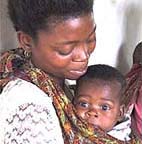| |

March 2002
Return to March
2002 contents page
NEWS
Board accepts ‘reward’ approach to funding
must be postponed
|
THE ALLIANCE is to revise its plan
to award performance-based grants to countries for increasing
the number of children they immunize. The changes, agreed
this month by the GAVI Board, are intended to make the grants
system more practical and realistic and will give countries
more time to strengthen their reporting of immunization data,
without abandoning the principle of “rewarding”
improvement.
The immediate consequence is that,
instead of being assessed for their first “reward”
payment in their third year, countries will have an extra
year of investment support, regardless of performance. The
reward payment will kick in in the fourth year. For the first
group of 16 countries approved for support for their immunization
services in 2000, the first reward payments will be made in
2003 rather than 2002.
Although some may see the decision
as a setback for the Alliance’s way of working, others
are simply pragmatic. “The revised approach is the most
practical and equitable option,” says Michel Zaffran
of WHO, a member of the GAVI Working Group. “We are keeping
the original principles – giving countries an opportunity
to define weaknesses and encouraging their efforts to improve
immunization coverage and reporting systems. But we had to
take account of reality.”
|
|
|
| |
Keep my clinic
records safe, too: reporting systems need more investment before
funding can be based on performance |
Back in 2000, GAVI agreed that countries
should be rewarded with “shares” for increasing the number
of children immunized each year with three doses of DTP (DTP3) chosen
as a measure of coverage. For example, if a country increased the
number of children receiving DTP3 from 100,000 to 120,000 it would
be awarded 20,000 “shares”. To discourage over-reporting,
a data quality audit (DQA) was developed (see Immunization Focus,
June 2001 and October
2001). External auditors were to check that the number of reported
immunizations tallied with the numbers actually recorded.
|
|
But field tests of the DQA last
year in eight countries found “significant weaknesses”
in the data reporting systems of seven. A report for the Board
by the GAVI Task Force on Country Coordination concluded that
it was too soon to introduce performance based funding. “Most
countries... will initially be unable to demonstrate valid
reported DTP3 data,” the report said.
While the original idea was that
the amount awarded to each country would be adjusted to match
the verified percentage of children receiving DTP3, the report
concludes that this would be unworkable. No practical audit
method would be able to check figures with the precision required
to adjust funding in this way, the report says. Another serious
problem with the audit is its cost – at $60,000 per country,
it is not much less than the awards to some countries.
|
| Data check: auditors and
staff examine the records at a clinic in one of the pilot tests
of the data quality audit, in Kenya, last year |
|
The task force recommended
changes in the way performance is assessed. This year, the DQA should
be used in all countries, but only to gauge whether the reporting
system is broadly "reliable" or "unreliable". Reliable systems will
be defined as those in which 80% or more of reported immunizations
can be verified by the auditors. All countries, whether their systems
are "reliable" or "unreliable", will receive the extra investment
payment this year.
|
Next year, those
countries whose systems are judged reliable will receive awards
if their reported coverage increases, with figures endorsed
by the country’s interagency coordinating committee (ICC).
Those with unreliable systems will in principle have their
rewards deferred until they have improved their reporting
systems. They could also choose to demonstrate, through a
coverage survey, that they have achieved their target. But,
says Zaffran, the use of coverage surveys will be limited
and will follow strict criteria. In the longer term, GAVI
partners are to investigate using other indicators besides
DTP3 to assess the overall "health" of the immunization system.
|
|
|
| |
Under
scrutiny: immunization records, like these in Kenya, must be
well maintained |
Since GAVI
first proposed it, the idea of basing grants on performance has
attracted the interest of other players in international development,
most recently the Global Fund to Fight AIDS, Tuberculosis and Malaria.
But for the model to work, countries need to have clear and robust
indicators for measuring performance, as well as the capacity to
collect the data.
"One of the
lessons we have learnt is that it is more complicated than one might
think to set up a very simple model where you link disbursements
to results," says Anders Nordstrom, interim executive director for
the Global Fund, who is seconded from his post as head of the health
division at the Swedish development ministry, SIDA. Nordstrom is
confident that performance-based grants will remain central to future
funding methods. But countries need long-term support to develop
their own capacity for keeping clear health records to make this
possible. Another lesson, he says, is for the donor community. "We
have to change our own behaviour, too," he says. For example, donors
should agree a small set of simple indicators rather than require
countries to provide multiple sets of data.
Phyllida Brown
The Task Force report will be
posted with all Board documents at www.vaccinealliance.org
Return to March 2002 contents
page
|

